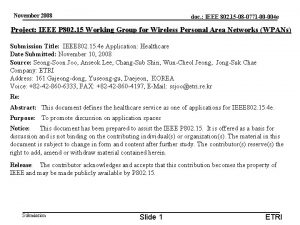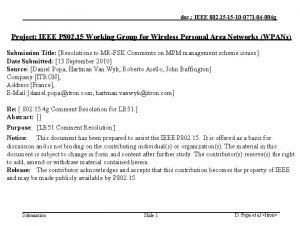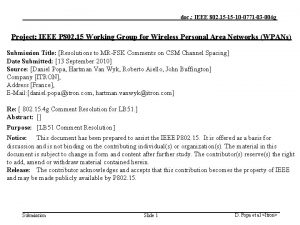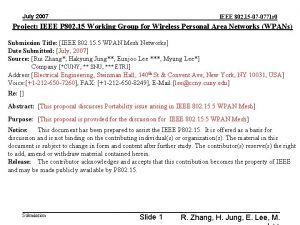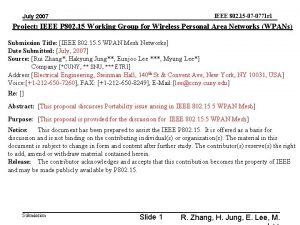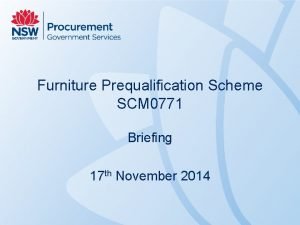doc IEEE 802 15 15 10 0771 02








- Slides: 8

doc. : IEEE 802. 15 -15 -10 -0771 -02 -004 g Project: IEEE P 802. 15 Working Group for Wireless Personal Area Networks (WPANs) Submission Title: [Resolutions to MR-FSK Comments on CSM Channel Spacing] Date Submitted: [13 September 2010] Source: [Daniel Popa, Hartman Van Wyk, Roberto Aiello, John Buffington] Company [ITRON], Address [France], E-Mail: [daniel. popa@itron. com, hartman. vanwyk@itron. com] Re: [ 802. 15. 4 g Comment Resolution for LB 51. ] Abstract: [] Purpose: [LB 51 Comment Resolution] Notice: This document has been prepared to assist the IEEE P 802. 15. It is offered as a basis for discussion and is not binding on the contributing individual(s) or organization(s). The material in this document is subject to change in form and content after further study. The contributor(s) reserve(s) the right to add, amend or withdraw material contained herein. Release: The contributor acknowledges and accepts that this contribution becomes the property of IEEE and may be made publicly available by P 802. 15. Submission Slide 1 D. Popa et al <Itron>

doc. : IEEE 802. 15 -15 -10 -0771 -02 -004 g Comments ID: 728, 749, 750, 1160 Submission Slide 2 D. Popa et al <Itron>

doc. : IEEE 802. 15 -15 -10 -0771 -02 -004 g Comments ID: 749, 750 CID #749: ECC REC 70 -03 require channel spacing < 100 k. Hz for narrowband modulation and wideband modulation other than FHSS and DSSS CID # 750: ECC REC 70 -03 require channel spacing < 100 k. Hz for narrowband modulation and wideband modulation other than FHSS and DSSS Requested resolution: Change channel spacing to 100 k. Hz for the common signaling mode. Response: The solution described in document 15 -10 -0771 -02 -004 g slide 8 delivers a simple and efficient solution. Proposed resolution: Reject. Submission Slide 3 D. Popa et al <Itron>

doc. : IEEE 802. 15 -15 -10 -0771 -02 -004 g Comments ID: 728, 1160 CID #728: The channel spacing for the mandatory data rate (50 kbps) in 915 MHz and 2. 4 GHz bands should not be restricted to only 200 k. Hz. Switching from the MR-FSK mandatory 50 kbps / 200 k. Hz channel spacing to MR-FSK 150 , 200 kbps / 400 k. Hz, as well as when switching from the MR-FSK 50 kpbs / 200 k. Hz to MR-O-QPSK or OFDM adds useless design burden and might increase the power consumption. CID #1160: The channel spacing for the mandatory data rate (50 kbps) in 915 MHz and 2. 4 GHz bands should not be restricted to only 200 k. Hz. Switching from the MR-FSK mandatory 50 kbps / 200 k. Hz channel spacing to MR-FSK 150 , 200 kbps / 400 k. Hz, as well as when switching from the MR-FSK 50 kpbs / 200 k. Hz to MR-O-QPSK or OFDM adds useless design burden and might increase the power consumption. Requested resolution: Add a new PIB attribute phy. Channel. Spacing. CSM (integer value) that takes the following values: phy. Channel. Spacing. CSM = 0 indicates the mandatory mode for MR-FSK uses 200 k. Hz channel spacing; phy. Channel. Spacing. CSM = 1 indicates the mandatory mode for MR-FSK uses 400 k. Hz channel spacing. Response: Adding a new PIB attribute will challenge the interoperability goal because devices might not share the same context. Instead, a more simpler solution consists in aligning carrier frequencies for 200 k. Hz and 400 k. Hz channel and allowing CSM message exchanges only on those 200 k. Hz-spacing channels that align with the 400 k. Hz-spacing channels. This is additionally benefic for FHSS, as it decreases the convergence time for the synchronization of unsynchronized devices. Proposed resolution: Accept in principle. See slide 8 of document 15 -10 -0771 -02 -004 g for resolution. Submission Slide 4 D. Popa et al <Itron>

doc. : IEEE 802. 15 -15 -10 -0771 -02 -004 g MR-FSK channel plan for 915 MHz Band: MR-FSK PHYs 200 k. Hz channel numbers 0 902. 2 1 2 3 4 5 6 7 8 902. 4 902. 6 902. 8 903. 0 903. 2 903. 4 903. 6 903. 8 Channel plan for MR-FSK mandatory mode @ 50 kbps & 200 k. Hz channel spacing Channel plan for MR-FSK optional modes @ {150, 200} kbps & 400 k. Hz channel spacing 400 k. Hz channel numbers 0 1 2 3 902. 4 902. 8 903. 2 903. 6 CSM uses the mandatory MR-FSK PHY mode @ 50 kbps and 200 k. Hz channel spacing Submission Slide 5 D. Popa et al <Itron>

doc. : IEEE 802. 15 -15 -10 -0771 -02 -004 g Issue: It is inefficient for an MR-FSK FH system operating at optional modes to exchange information with an MR-FSK unassociated device using CSM, if the center frequencies of the channels they use to exchange messages do not coincide. Solution: Require that the unassociated device exchanges CSM messages only on the odd 200 k. Hz channel number. Note: 1. CSM is optional; 2. CSM needs only to demonstrate the capability of communicating using the PHY; 3. A PHY capable to communicate in every 200 k. Hz channel spacing can also communication only on odd channel number. 4. This resolution does not add any additional requirements to the existing PHY. Submission Slide 6

doc. : IEEE 802. 15 -15 -10 -0771 -02 -004 g Example at 915 MHz 200 k. Hz channel number 0 1 2 3 4 5 6 7 8 902. 2 902. 4 902. 6 902. 8 903. 0 903. 2 903. 4 903. 6 903. 8 400 k. Hz channels 902. 4 902. 8 903. 6 903. 2 200 k. Hz odd channel numbers Submission Slide 7 D. Popa et al <Itron>

doc. : IEEE 802. 15 -15 -10 -0771 -02 -004 g Insert the following text For a MR-FSK frequency hopping systems operating in the mandatory mode, the commands exchanged during FH acquisition process shall use the channels whose center frequencies coincide with the center frequencies used by the MR-FSK optional modes. Submission Slide 8 D. Popa et al <Itron>









